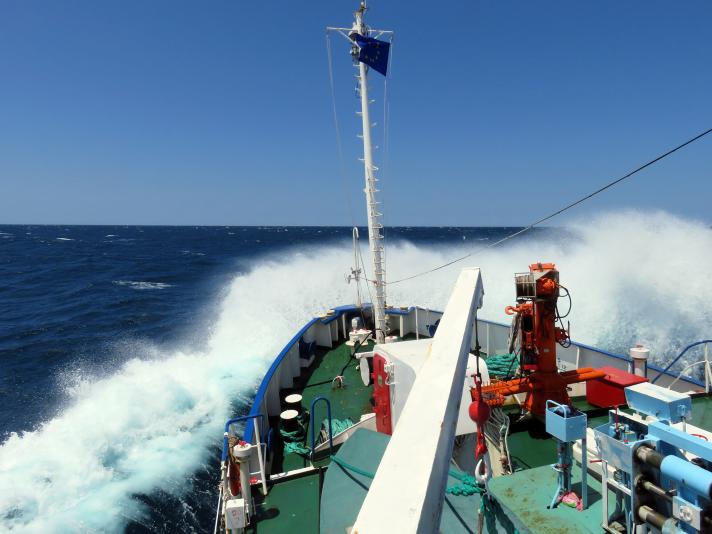
What are we talking about?
Observing the world’s oceans and the colour of sea water itself can tell us a lot about the health of marine ecosystems and the impacts of climate change.
For decades, scientists have gone to sea to take water samples and analyse them using sophisticated optical instruments at onshore labs. These expeditions take time, sailing between different test sites and back to land-based laboratories for analysis. More importantly, these expeditions only allow researchers to get a snapshot of the marine ecosystem at a few specific places and times.
Recognising the value of observing our oceans, the EU Space Agency deployed a constellation of satellites which carry equipment that allows them to observe sea water from space. These satellites are the backbone of the EU Copernicus programme, which gives scientists access to data for a whole range of purposes. The advantage of these Copernicus services is that vast areas can be observed in almost real-time and can give an overview of all the Earth’s oceans in just one day.
What is the problem?
The main drawback is that there is uncertainty when observing the Earth from space. Our atmosphere interferes with the light that satellites detect, and sea water itself contains many chemicals, particles and organisms which all interact differently with sunlight. Moreover, the optical equipment onboard the satellites needs to be calibrated just like the equipment in onshore labs. But unlike in ground-based labs, a scientist can’t physically calibrate the satellite equipment.
Researchers have been working to solve these problems by building up bio-optical reference measurements. These data compare the readings taken from ships and platforms at sea, with readings from satellites that observe the same locations. Analysing the discrepancies between these data allows researchers to develop tools to compensate for the uncertainties with satellite images. In turn, these tools ensure that the data coming from satellites can be corrected very effectively which makes analysis of that data as accurate as possible.
The JRC Marine Optical Laboratory (MarLab) is specialised in developing methods and performing reference measurements to evaluate the readings taken from satellites . Their work helps define the uncertainty in satellite data and improves the methodologies and protocols for taking measurements at sea.
We still need researchers at sea to take samples to compare with satellite data, but with just a handful of expeditions we can ensure that our satellites give us a clear view of the whole planet.
How does looking at the colour of sea water help tackle climate change?
The ocean covers 71% of our planet’s surface and is home to roughly 94% of all life on Earth. However, according to the 2019 IPCC special report, the ocean has absorbed about a third of the carbon dioxide emitted from burning fossil fuels since the Industrial Revolution, and more than 90% of the excess heat within the Earth’s environment. As a result, the oceans are getting hotter and more acidic. This has major impacts on marine ecosystems, particularly the many different species of plankton which give the ocean much of its colour. By tracking changes in the colour of our oceans, we can also track the health of the marine environment and the impacts of climate change. The EU Copernicus Climate Change service depends on satellite imagery to be able to produce regular bulletins on the state of climate change, drawing heavily on ocean colour data. But this can only be done when we have reliable methods to standardise measurements, to validate data and calibrate instruments.
What is new?
This year, scientists working at the Marine Optical Laboratory are publishing a compendium of 30 years’ worth of data obtained in the context of satellite ocean colour interpretation and validation. Working in collaboration with national laboratories in European countries, and international partners like NASA from the USA, our scientists have developed the most comprehensive set of data ever collected in European seas. What sets this apart from other research is that standardised methods and instruments have been used throughout the 30 years of study. This very consistent approach means the data collected is time consistent and of a very high quality. This is invaluable to scientific research as part of the EU Copernicus programme, and to the global scientific community.
What happens next?
JRC scientists will continue their work, adding to this dataset and carrying out more expeditions in the future. However, the ambition is for this work to be used in more ways now that such a comprehensive dataset has been put together. It will continue to help with validation and assessment of the uncertainty of satellite data. It is also hoped that it can be used for higher level studies that will help address climate change, ecosystem monitoring, and strengthen the science and techniques for ocean colour interpretation itself. International collaboration will also continue. NASA’s interest in the most recent expeditions for example is related to the launch of the new “PACE” satellite which, assisted by JRC and the international community research, will improve monitoring of ocean phytoplankton.
Related links
Find out more about the JRC Marine Optical Laboratory
Read more about the Copernicus Climate Change service
Learn more about the 2019: IPCC Special Report on the Ocean and Cryosphere in a Changing Climate
Details
- Publication date
- 21 November 2024
- Author
- Joint Research Centre





